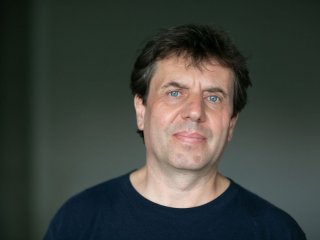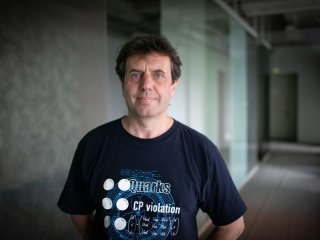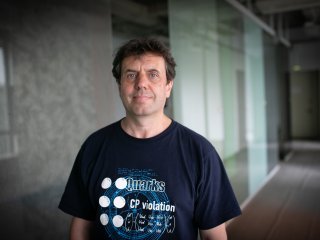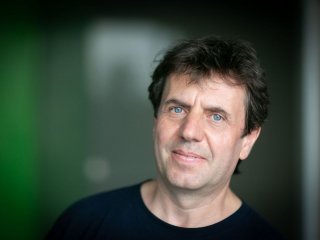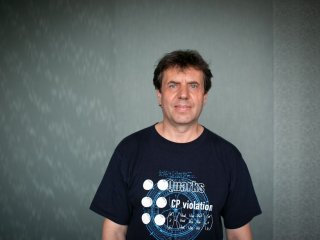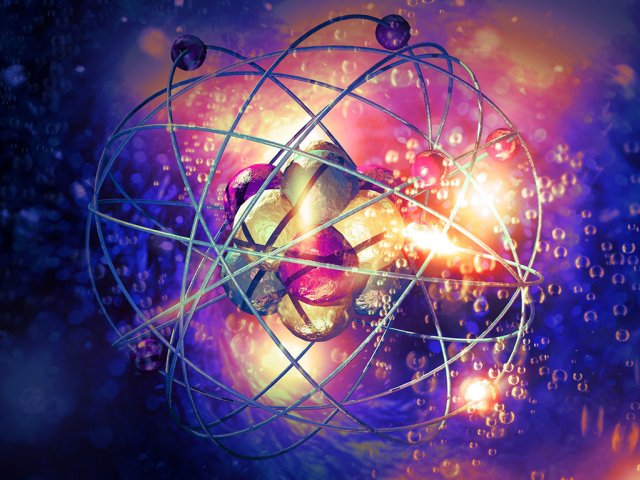What role does the concept of God plays in the existence of the Universe? What is God in terms of physics? Does antimatter exist? What is dark matter and can it be registered? Why do physicists believe there is a need for a new theory that will change our idea of the world?
Pavel Nikolaevich Pakhlov, Head of Heavy Quarks and Leptons Laboratory at Lebedev Physics Institute of the Russian Academy of Sciences, is reflecting on these questions.
– Pavel Nikolaevich, elementary particles are not so elementary after all, are they? Is the matter complicated?
– It’s not simple. We are experimenters, although my laboratory has theoreticians as well. We indeed investigate the smallest objects we can reach. Now, we get to work with objects that are smaller than a proton. Every subsequent order infinitesimal is harder to reach. To study physics with objects the size of 1/1,000 of a proton, a large hadron collider had to be built, which cost billions of Swiss francs. This must be the largest scientific project ever undertaken in the history of humanity.
– Pavel Nikolaevich, why do we need to see, record and register the smallest particles of our matter?
– That would provide answers to a lot of questions. We learn how the macro world works by investigating it on the micro level. For instance, to understand the workings of the human body, we had to create microscopes, which showed us that all living objects consist of cells. This was done by the splendid English physicist R. Hooke who was the first to see those cells. To understand how we work, we have to understand how a cell works. And to understand how the world works we have to examine even smaller objects. We are also driven by mere curiosity, of course. People explore everything there is to explore. We can't help it. It’s our nature. The Church fought human curiosity for a long time. But it always survives no matter what.
– It was because Church believed that we should not try to understand God’s design.
– I think that their motives in the Middle Ages were more prosaic, more practical, such as fear that answers to many questions that physics, mathematics, and astronomy would look into might not be consistent with the answers provided by the Bible. Curiously enough, no calamity has befallen the Church. The Catholic Church has been faithful to its idea of fighting science for a long time. But science is quite indifferent to the Church, and is not trying to fight it in return.
– When studying continents, geologists very often see correlations with the Holy Scripture. The Great Flood, for instance. It turns out that the Bible even offers some clues. Do you have similar experience in your work?
– I’ve never thought of it, to be honest. But I will. I’ll study the Bible in case it does contain some clues.
– Can you say that you don’t need the God hypothesis?
– I wouldn’t say so. I know, some physicists believe in God and go to church and that is no obstacle to them. I don’t need that, but I don’t see any contradictions between God and science, unlike priests by the way, who do see such contradictions. I feel that many priests are a little too narrow-minded. I think that the concept of God does not require personification or an idea of God as a physical being. There is no need for an image of God. By the way, many religions prohibit that. God is just a supreme idea; we have something like that in physics: the unified theory of interactions. Analyzing your previous question, I would say that the theory may serve as God because it rules the world essentially.
– Pavel Nikolaevich, our conversation has taken an interesting theological turn. You mentioned the Large Hadron Collider, a project in which, as I know, you are involved as well. When the Higgs boson was finally registered by the collider, the boson was called “God’s particle.” Why do you think this happened?
– It was called that because the Higgs boson was and is thought to be the fundamental particle from which everything else started. The Higgs boson doesn’t interest us as much as its basic mechanism. It was designed, by the way, using a theory that was originally created for solids rather than for particle physics. The idea was proposed by L. D. Landau and V. L. Ginzburg, our wonderful scientists. Later, the idea was applied in particle physics by P. Higgs and his co-workers.
The idea involves spontaneous violation of symmetry, when you can choose between two non-symmetrical options and there is no difference between the two, but both are better than the symmetrical option. It’s a typical example of Buridan's ass that is hungry and has two identical carrots before it to choose from. To say that the animal will starve to death, unable to choose between the identical carrots is wrong. Essentially, Higgs’ idea was that nature, when in state when it can fall to the left or to the right, will fall someplace. This is a remarkable idea, meaning that nature has chosen one of two totally equivalent states, which is better than the middle state, while there is also another state that is no different to the one chosen. Thus, our vacuum, the thing we live in, turned out to be filled with this substance – the Higgs condensate.
– Moreover, vacuum turned out to be not a void as we were taught at school, but a place totally filled with diverse matter.
– Our ideas of what vacuum is has changed many times. By the way, vacuum was invented by the ancient Greeks. They thought of an atom that people could not see until the 19th century. The Greeks thought that if we started crushing matter, at some point we would get something we wouldn’t be able to split any further. Having invented atom they also invented vacuum as they needed some place for it. In fact, the invention of vacuum by the ancient Greeks, which is less talked about, was an equally great invention.
– As far as I know, the Greeks did not see vacuum as a void.
– They saw it as a place to put atoms in. They didn't believe they should think of how it worked. What’s great about the ancient Greeks is that they tried to run an experiment in their minds. We are performing a physical experiment now; we are building the Large Hadron Collider, spending an awful lot of money; we’ve been working for 10 years, digging an underground tunnel, installing magnets and most sophisticated detectors. The ancient Greeks just sat under an olive tree, reflecting. What’s more is that the fruit of their reflections was no less impressive. Perhaps they were not as convincing in their conclusions as we are…
We should keep in mind that there were two theories of the Universe in Ancient Greece. One of them was the atom-based theory we like to remember because atoms were practically rediscovered in the 19th century. The other theory pictured the world as a substance that had clots in some places and was more rarefied elsewhere. The two theories co-existed for hundreds of years as the two schools could not prove which one of them was right. However, both schools had students and could explain to them how to run that mental experiment in order to see the world on the scale the eye can’t see. The students saw it, but it was in their heads, and they used their minds to learn to see it in reality. I would say that they were more intelligent than we are in that regard, because we can’t do that.
– Because it occurred to them in the first place?
– Yes, it did somehow, while we managed to think of that because we had been doing experiments all the time. Science has been following this practical path since the 16th century – the Renaissance period. To understand how objects fall, Galileo started experiments to see how they slid down a sloping surface, and he measured the time. That was when science took an entirely different direction and it happened with all natural sciences: we do experiments now. In other words, we ask that God what happens if we do this or that.
Galileo was asking how small balls were going to act on a sloping surface, how long it would take them to roll down a flatter or steeper slope, or with different starting points. He was asking questions to God, to Nature – whatever you want to call it. What’s great about that is that Nature always tells the truth. We may misinterpret its answers, but the great thing about experiment-based science is that we always get correct answers to direct questions to Nature.
– Pavel Nikolaevich, what questions did you ask Nature, God, the Universe at your laboratory, to which you have received the right answers?
– As for the right answers, it’s too soon to draw final conclusions. It takes time and more experiments. We are researching heavy quarks. We know that the world around us consists of atoms, which, in turn, consist of something else. Although an atom is, by definition, indivisible, people were too hasty in giving it this name. Because atom was actually invented by chemists, not by physicists, while for chemists an atom is an indivisible substance since in all chemical reactions, atoms are just moved from one molecule to another, without disintegration.
Nothing is sacred for physicists, so they broke up an atom and took out some pieces out of it. First, they learned how to extract an electron; then they found out that an electron is just a tiny part of an atom. The bulk of the atom is in its nucleus. They found out what nucleus is, and that it consists of protons and neutrons. Only fairly recently, 50 years ago, physicists found out that protons and neutrons also consist of something. They consist of quarks. They contain two types of light quarks. First, light and stable quarks were found, and then it suddenly turned out that Nature had also created some heavier and less stable quarks for some reason. They seem to be totally unnecessary for our Universe since all things around us consist of light quarks.
Heavy quarks may be generated by a collision of two very energetic particles. That may create some heavy, strange quark, for example. Such things happen, for instance, in the upper layer of the atmosphere due to solar particles reaching Earth from the Sun. By colliding with atoms in the upper layers of the atmosphere, protons may generate strange mesons that contain strange quarks. Strange mesons even reach us sometimes; they reach Earth and go through us. It’s neither painful nor frightening, but it happens.
It would seem to be the only influence of heavy quarks on our existence. When they are born, there is very few of them, so they can’t really affect our health.
It seemed so for a long time. Everyone thought that Nature had made something superfluous for some reason. However, Nature doesn’t normally make superfluous things. Which has been proven in this case as well.
– So what are those quarks for after all?
– The thing is that, in addition to strange quarks, there are heavier quarks. They are very rarely born. While strange quarks fly through us every minute or so, heavier quarks have such short lives that they can't affect anything, and their birth rates are two or three times lower. But what are they for?
Strangely enough, we found the answer to this question in the understanding of how the outer space works and how astrophysics, the science studying the history of the Universe, works. We can use our current observations to determine what the Universe looked like before and how it all started. It’s important to mention the idea of symmetry at this point, because there are antiparticles as well as particles. Their existence was also discovered recently – less than a century ago.
British physicist A. Schuster came up with the idea for considerations to do with symmetry. He thought: if an electron is negatively charged why isn’t there an identical one, but positively charged? There must be, the world being symmetrical. Symmetry is a rather serious consideration, which gives us a clue that a positively charged electron must exist as well. Schuster was told that, of course, that was an excellent argument, but everyone knew there were no such electrons. He was told “We can see millions and billions of electrons; they cause cathode rays; but we see no positrons. Therefore, they don’t exist.”
And the idea was forgotten for 30 years. P. Dirac essentially revived it, but he went about it in a more scientific manner. He didn’t use general considerations, but proved instead that there have to be positrons to explain the stability of electrons. And just three or four years later, positrons were discovered in cosmic rays, confirming that brilliant idea.
We have antiparticles, which are indeed symmetrical to particles. The properties of matter are virtually indistinguishable from those of antimatter. Actually, they were believed to be exactly the same for a long time.
– Getting back to the idea of Buridan's ass: why is it that the world chose matter and rejected antimatter?
– This is a most important question. There is another consideration, one that our Universe was born with the Big Bang, when this symmetry between particles and antiparticles was not broken. So, something had to be done about the antiparticles; a mechanism was needed to remove them and tell us why there were no antiparticles around us. Everything consists of particles: every star, you and I, and other galaxies. We know that because, if the neighboring galaxies were antigalaxies, particles and antiparticles would be annihilated at the border, in the intergalactic space, and we would be able to see the signals of annihilation. Various experiments were performed for a very long time in order to find such signals, including space experiments, when a detector was connected to a satellite and used to try and find the signs of annihilation of matter and antimatter. Nothing was found. That means there is no antimatter.
At the time those questions were first asked, it was discovered by chance that matter and antimatter are slightly different in their properties. The symmetry between them is enormous. This tiny difference is very hard to see: it’s incredibly small indeed. But we did see the difference and realized that the symmetry, though real, was not quite perfect.
Then those two wonderful facts were linked: the fact that matter and antimatter have slightly different properties and the fact that antimatter had gone somewhere. It was actually done by Andrey Dmitrievich Sakharov, in the 1960s.
– And he worked at RAS Lebedev Physics Institute at the time.
– Sakharov is one of the people who are the pride of RAS LPI. The Institute celebrated the 100th anniversary of Andrey Sakharov just two months ago. He was a fantastical person and scientist. He was interested in many different things, and particle physics wasn’t his main area. However, he made his contribution to it. Every scientist working in particle physics across the world knows this. Sakharov is remembered for his brilliant explanation of the “disappearance” of antimatter. Everyone understands today: for antimatter to “disappear” someplace, its properties have to be somehow different from the properties of matter. This is one of the three Sakharov’s postulates our world’s origin.
A few years later, in 1973, two Japanese scientists – M. Kobayashi and T. Maskawa – thought of a mechanism to make antimatter disappear. Why are the respective properties of matter and antimatter different? That was where those heavy quarks came into play. The very same that have no impact on our lives and appear useless. But they did have an impact at the beginning. Their existence made things as they are today. An amazing thing about physics is that an object affects the Universe by the fact of its existence alone (“backstage”) rather than directly (“by appearing on the stage”). We don’t have to generate them to do that, although we know how to. Their very existence, the very possibility of their existence makes a difference for the evolution of the Universe and for our existence.
– And if their weight were to change even by a tiny fraction, the world would be quite different or, perhaps, it would not exist at all. As far as I know, this relationship is called the anthropic principle, thanks to which we all exist.
– Perhaps, it’s just that we don’t know the main original idea behind this entire project.
– You mean, the main God’s design?
– Yes. We don’t know the main God’s design, and what the Big Bang was for. Perhaps, it was done for us to be born and discuss how the world works.
Look, these particles that don't have to be born directly still affect the world by being able to be born virtually. Physicists came to an amazing realization at the start of the 20th century: quantum mechanics is changing our understanding of the world. We used to believe that the world was like a set of balls and points flying somewhere, colliding and bouncing, but quantum mechanics told us there was no such thing. No balls. An electron is not a ball. It is more like a cloud, spread in space, while we can’t even locate it precisely. Here, quantum mechanics didn’t just change our understanding of the world; it practically affected the world. We are talking via Zoom now, and all computer technology is quantum mechanics.
When the transistor was invented, the world took the path towards computers, cell phones, and smart watches. Obviously, transistors would have never been invented if people hadn’t known the laws of Nature. It is hard to imagine that someone would take some sand from a beach, start shaking and melting it, and produce a transistor accidentally. No, it was made by working purposefully. First, the laws of Nature were learned. We got back to our first question – when you asked me why. Knowing the laws operating on the macro world level, people managed to invent a transistor, for instance, and then a microchip. Then they made computers and other gadgets. The basis of all that was the quantum laws discovered in the early 20th century.
– Pavel Nikolaevich, but where did antimatter go after all?
– It annihilated. That is, it’s not there in fact. But it can be born now. By the way, there is a band of antiprotons around Earth. It’s very rarefied. The antiprotons are circling around Earth at some distance where there is no atmosphere, and they get caught into a magnetic field. I mean, that, in principle, they can be born and exist forever as long as they don’t come into contact with matter.
Clearly, they don’t live long in our Universe. Originally, when matter and antimatter were born in equal amounts, they annihilated. And because of a slight difference in their respective properties, antimatter disappeared almost entirely while some matter remained. There is very little left of it compared to how much there was at the start.
– And the rest of existence is dark matter, as we know. I am aware that you are also involved in research aimed to find the particles that may be responsible for the existence of dark matter. Neutrinos play an important role here.
– They may. At the end of the day, we know of the existence of dark matter from astrophysical observations. We realize that, apparently, there must be some massive objects that only interact through gravitation. Those are some fantastical objects that are sterile as far as any other interactions are concerned. All massive particles we know are charged, except the Higgs boson. They have a charge, therefore they can radiate photons, emit light.
But those particles don't emit light; they have no charge. That is why they are called dark matter actually. They appear to interact by gravitation only. The astrophysical observations that prompted the idea of dark matter were performed in the early 1990s, i.e., quite a long time ago. Scientists have been trying to find dark matter for 30 years, to no avail. We can't see any sign of such particles.
That gives rise to doubt: Might there be some other explanation for those astrophysical observations?
– Perhaps, other methods are required to detect the particles?
– The catch is that to be detected by any method, they have to interact with our matter in some manner other than by gravitation. If that doesn’t happen, we have zero chance of detecting the particles in our experiment. We believe that there is some kind of interaction, with the normal material world, even if it's very weak. Then we’ll be able to see them pushing, the way it happens in Brownian motion of atoms. In principle, there must be many dark matter particles.
There are two paths at the moment. One is direct search for the particles, which has been on for 30 years and failed so far. Increasing accuracy by an order of magnitude means increasing the mass of whatever you register tenfold. And that would be 10 times more expensive.
Our experiments are quite costly; they are an expensive pleasure. They are not cheap for taxpayers. Cheaper than wars and other senseless expenses, but still.
– And the other path?
– The other path is to think of explanations in theory.
– You mean the heuristic method the ancient Greeks indulged in?
– Yes. Even the fruitless search for dark matter actually hasn’t been totally fruitless. We know quite a lot about dark matter already. For instance, if it does exist, its interactions are very weak. There is something restricting the power of its interactions with our world. This means a lot. This limits the possibilities as to what kind of particles they are.
You mentioned neutrinos. This was another brilliant idea as well and another reason to remember Academician Sakharov. He came up with three conditions that explained the existence of our world. The second condition is baryon number violation, for protons to be able to decay. There are ongoing experiments in this area as well, very similar to the search for dark matter in that both types of experiments require a huge number of detectors, and we need to observe very rare events with very weak manifestations. There is also a search for proton decay. We know that protons are already over 1033 years old, i.e., older than the Universe.
Baryon number violation is another mystery in particle physics, but it is necessary for the existence of our world. Scientists are trying to understand how the neutrino sector can affect both those phenomena, provide a candidate for dark matter with very weak interactions with our substance, and think of a method for using neutrinos to violate the baryon number.
– I know that there is the axion theory that may try and explain the existence of dark matter. Do you think there may be some particles we can’t register at all that are in fact dark matter?
– Good question. Particles that don’t interact with our world in any way, but can have an impact on it?
As I said, the very fact of there being heavy quarks makes the respective properties of matter and antimatter different. But could there be any particles that affect our world indirectly, without interacting with it in any way? I don't know. Could we detect them somehow? I don't know. As far as I understand it, all ideas we have are based on there being some kind of interaction. All detectors built to detect such particles always require such interaction, even if it’s very weak and with very low interaction constant. At present, there is no method to detect the particles if they really don’t interact at all.
– Do you think there are many particles that haven’t been registered?
– That’s a complicated issue. At the very least, we know that our theory is incomplete. It is a very good theory. It’s excellent, it works and can be proven by experiment with a good level of accuracy. It's been there for 50 years. It is called the Standard Model. But we know that it is incomplete, because it has many holes in it we don’t like. There are contradictions and unexplained facts in this theory, including with regard to dark matter, and some other things too. Which means that there is a more global theory.
An experiment with anomalous magnetic moment for the muon has produced some indications to a contradiction to the Standard Model. If this is confirmed, there is going to be a most interesting era. That would mean we’ve found something new. And it’s high time we found it: the theory would break at last, and we would understand where to go next.
Now, we don’t know where we should go in theory development. We don’t have the answer, since there is a theory that is incomplete and not quite satisfactory to everyone, but is nevertheless fully consistent with the experiment. Therefore, it is very hard to move forward. The direction is unknown. Perhaps, a new theory will generate a multitude of new particles, or describe the structure of existing particles. That is, it should change our idea of the world drastically.
– Pavel Nikolaevich, do you think that people can get to know the world they live in, the world that created them, in its entirety?
– At that moment, humans would be equal to God. We know one such example – Jesus Christ. He had been born a man and became God once he learned everything. Buddha did the same. Could anyone else achieve that and how? I don't know.
– But would you like to?
– I think it’s boring. To know everything practically means to die. You know, that's the moment your life ends. You wouldn’t be able to live on. Childhood, when we didn’t know much, was a happy time. Knowledge often limits the freedom of action. We’re pursuing knowledge all the same. There is nothing that can or should be done about that. But reaching absolute knowledge just means death, as far as I understand it. And we want to live, don’t we?
Interviewer: Natalia Leskova
Photo: Andrey Luft
Video: Dmitry Samsonov


